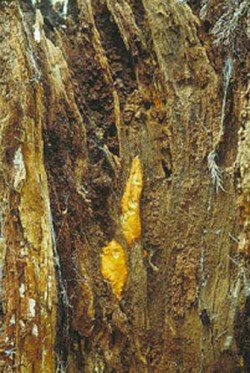TELDAP Collections
| Taiwanofungus camphoratus (牛樟芝) |

Introduction The fruiting body grows from the interior of the hollowed tree trunk of the Cinnamomum kanehirai Hay, an endemic tree in Taiwan , displaying its fondness of dark and damp environment. It is not yet known whether the hollowed trunk of this tree was caused by the rotting or decomposition by other fungus to pave way for the subsequent growth of T. camphorates. This fungus grows extremely slowly on sawdust, sometimes with no fruiting bodies at all. Therefore it is hard to artificially cultivate this species. It is possible to grow this fungus in liquid medium for consumption, but it depends on the hyphae having the same nutritional components as the mature fruiting body. This species is endemic to Taiwan ; it is a brown rotting type fungus found in old and hollowed trunks of Cinnamomum kanehirai Hay trees. It is expensive due to its rarity and incapable of being artificially cultivated. It is reported to have medicinal properties that alleviate abdominal pain, activates central neural system, and may have hypnotic effects. There have been tests performed to treat liver and endometrial cancers. The base name of the Chang-Chih was Ganoderma comphoratum M. Zang & C.H. Su: The holotype specimen was contaminated with Ganoderma spores, hence it was erroneously identified as one of the Ganoderma fungus. After re-classification, the name was changed to Taiwanofungus camphoratus (M. Zang & C.H. Su) Sheng H. Wu, Z.H. Yu, Y.C. Dai & C.H. Su as its new scientific nomenclature.
National Museum of Natural Science
|












